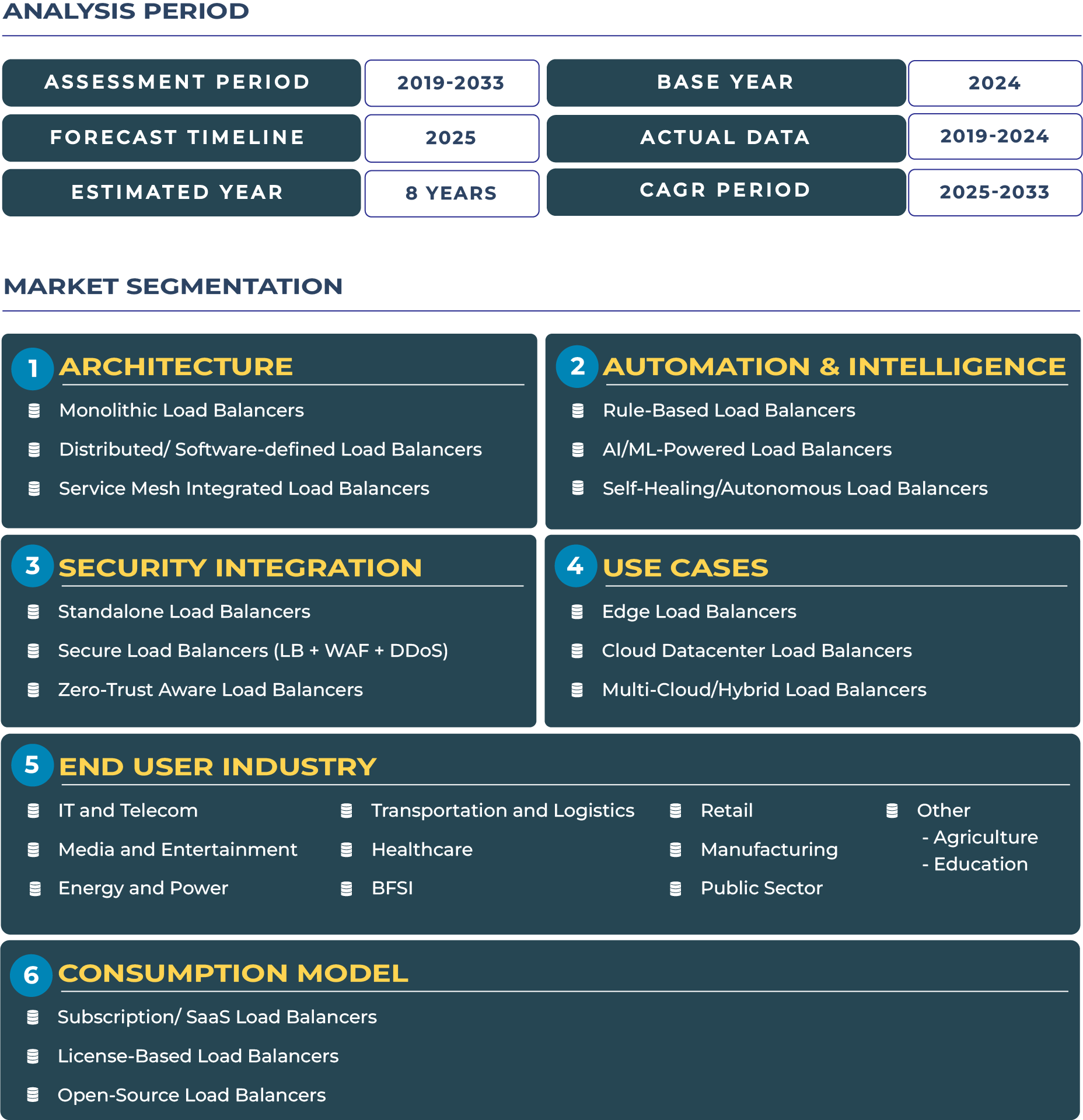Tech-First Digital Hub: Market Outlook of South Korea Cloud Load Balancers Market
South Korea has established itself as a tech-first digital hub, driven by leadership in telecom infrastructure, nationwide 5G coverage, and rapid adoption of cloud-native services. The country’s enterprise ecosystem, supported by advanced gaming, fintech, and e-commerce sectors, has created a unique demand for scalable and resilient traffic management solutions. The South Korea Cloud Load Balancers Market is expected to grow from USD 94.9 million in 2025 to USD 333.0 million by 2033, expanding at a CAGR of 17.0%. This performance reflects not only the high demand for distributed and service mesh integrated load balancers but also South Korea’s ability to position itself as a testing ground for ultra-low-latency applications. Political stability, strong economic performance, and proactive initiatives by the Ministry of Science and ICT have accelerated digital transformation efforts, enabling enterprises to adopt advanced cloud networking solutions. The strategic interplay of telecom leadership and enterprise modernization makes South Korea a standout market in the global cloud load balancers landscape.
Driving Forces and Restraining Factors Defining South Korea Cloud Load Balancers Market
South Korea’s advanced telecom infrastructure, combined with one of the world’s earliest nationwide 5G rollouts, is a major driver of growth for the cloud load balancers industry. Leading telecom operators like SK Telecom have been at the forefront of integrating distributed load balancers with ultra-low-latency networks to support gaming, video streaming, and enterprise workloads. The country’s status as a global gaming hub adds momentum, with esports and high-performance streaming platforms requiring robust, scalable, and secure traffic distribution systems. Additionally, South Korea’s enterprises are demonstrating high cloud adoption rates, leveraging distributed and software-defined architectures to modernize IT operations and prepare for edge-driven workloads.
Despite these advantages, the market faces restraints. South Korea’s relatively small domestic market limits scalability when compared with larger regional peers such as Japan or China. Competitive intensity among global hyperscalers and local players exerts pricing pressure, making profitability a challenge. Furthermore, rapid technology cycles in gaming, telecom, and financial services require enterprises to frequently upgrade or replace existing systems, creating cost pressures. These challenges underline the duality of South Korea’s market—highly innovative but demanding in terms of pace, performance, and continuous reinvestment.
Key Trends and Emerging Opportunities Shaping South Korea’s Cloud Load Balancers Landscape
South Korea is at the forefront of trends that are reshaping the cloud load balancers ecosystem. Ultra-low-latency edge deployments are becoming critical as gaming, fintech, and healthcare applications demand near real-time responsiveness. Telco-cloud integration is another trend shaping the market, with telecom operators co-developing solutions with cloud vendors to meet the performance needs of enterprises. Demand for high-performance Layer 4 load balancing is rising in response to increasing volumes of gaming traffic and financial transactions that require both speed and security. Collectively, these trends reinforce South Korea’s reputation as a high-performance, innovation-first market for cloud networking solutions.
Opportunities in the market are emerging through edge-based load balancing solutions tailored for gaming and esports—a sector in which South Korea remains a global leader. Enterprises are also exploring co-deployment strategies with telecom operators to deliver low-latency applications in metropolitan hubs like Seoul and Busan. Additionally, demand for high-performance load balancing products presents opportunities for both local providers and international entrants to capture share in South Korea’s digital-first economy. These opportunities demonstrate that the market is not only thriving but also maturing into a testbed for future-ready load balancing architectures.
Competitive Landscape: Strategic Collaborations Driving South Korea’s Cloud Load Balancers Sector
The competitive environment in South Korea’s cloud load balancers market is shaped by both domestic champions and international players. Local telecom leaders such as SK Telecom and KT Corporation are leveraging partnerships with global cloud providers like Amazon Web Services and Microsoft Azure to co-deploy traffic management solutions optimized for 5G and edge applications. In 2024, SK Telecom announced a collaboration integrating cloud-native load balancing for gaming and streaming workloads, ensuring latency thresholds are maintained even during peak demand. International providers such as F5 Networks and Citrix continue to expand their presence by aligning with South Korea’s strict cybersecurity and compliance frameworks. These partnerships and strategies highlight the centrality of telco-cloud integration and co-deployment models in driving growth within South Korea’s precision-oriented cloud load balancers ecosystem.







